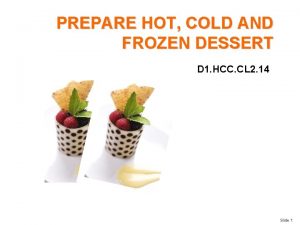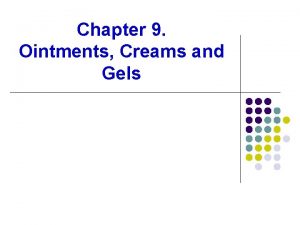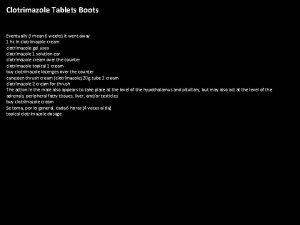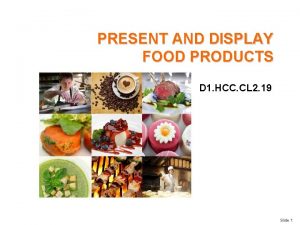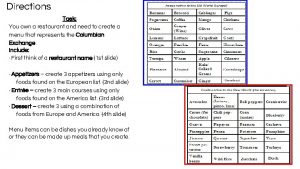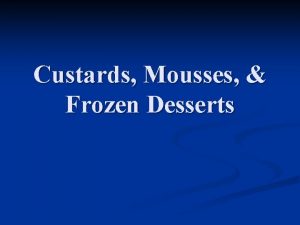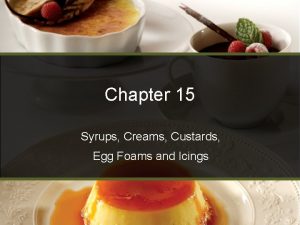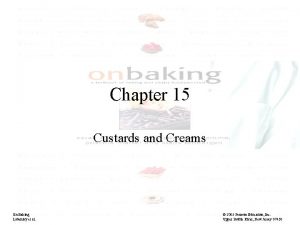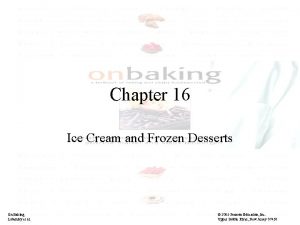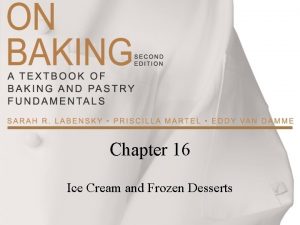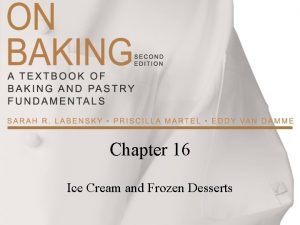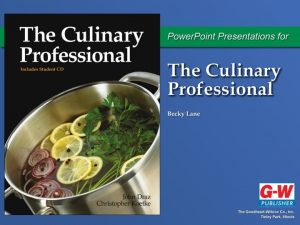Chapter 35 Creams Custards Puddings Frozen Desserts and













- Slides: 13

Chapter 35 Creams, Custards, Puddings, Frozen Desserts, and Sauces Copyright © 2011 by John Wiley & Sons, Inc. All Rights Reserved

Creams, Custards, Puddings, Frozen Desserts, and Sauces Sugar Cooking Basic Principles • A solution or syrup of sugar and water is boiled to evaporate part of the water. • As the water is boiled off, the temperature of the syrup gradually rises. • When all the water has evaporated, what you have left is melted sugar. 2

Creams, Custards, Puddings, Frozen Desserts, and Sauces Sugar Cooking Basic Principles • A syrup cooked to a high temperature is harder when it is cooled than a syrup cooked to a lower temperature. • One part water (by weight) is enough to dissolve and cook 3 to 4 parts sugar. • There is no point in adding more water than is necessary because you just have to boil it off. 3

Creams, Custards, Puddings, Frozen Desserts, and Sauces Sugar Cooking Simple Syrup • A solution of equal weights of sugar and water. • Combine equal weights of water and granulated sugar in a saucepan, stir, and bring to a boil to dissolve the sugar. • Cool the syrup. • Dessert syrup is a flavored simple syrup used to moisten and flavor some cakes. 4

Creams, Custards, Puddings, Frozen Desserts, and Sauces Sugar Cooking Crystallization • Graininess is a common fault in many candies and desserts. • Graininess results when cooked sugar crystallizes, or turns to tiny sugar crystals, rather than staying dissolved in the syrup. 5

Creams, Custards, Puddings, Frozen Desserts, and Sauces Sugar Cooking Crystallization • If even one sugar crystal comes in contact with a cooked syrup, it can start a chain reaction that turns the whole thing into a mass of sugar crystals. • Sometimes an acid such as cream of tartar is added to a syrup before cooking. • Acids change some of the sugar to invert sugar, which resists crystallizing. 6

Creams, Custards, Puddings, Frozen Desserts, and Sauces Sugar Cooking Stages of Sugar Cooking • Testing the temperature with a candy thermometer is the most accurate way to determine the desired doneness of a syrup. • In the old days, syrups were tested by dropping a little bit into a bowl of cold water and checking the hardness of the cooled sugar. 7

Creams, Custards, Puddings, Frozen Desserts, and Sauces Sugar Cooking Stages of Doneness in Sugar Cooking __Stage • • Thread Soft ball Firm ball Hard ball Small crack Crack Hard crack Caramel Temp. ° F 230 245 250– 260 265– 270 275– 280 290– 310 320– 340 Temp. ° C_ 110 115 118 122– 127 130– 132 135– 138 143– 155 160– 170 8

Creams, Custards, Puddings, Frozen Desserts, and Sauces Basic Custards and Creams • Crème Anglaise • A stirred custard. • Also called vanilla custard sauce. • Pastry Cream • Contains starch thickeners as well as eggs, resulting in a much thicker and more stable product. • Baked Custard • Baked so it sets and becomes firm. 9

Creams, Custards, Puddings, Frozen Desserts, and Sauces Basic Custards and Creams Sanitation and Food Safety • Use clean, sanitized equipment, and follow strict sanitation procedures. • Egg mixtures are good breeding grounds for bacteria that cause food poisoning. • Do not put your fingers in the product. • Do not taste the product except with a clean spoon. • Keep the product refrigerated at all times. 10

Creams, Custards, Puddings, Frozen Desserts, and Sauces Puddings Starch Thickened Puddings • Cornstarch pudding or blancmange • Consists of: • Milk • Sugar • Flavorings • And is thickened with cornstarch (or, sometimes, another starch). 11

Creams, Custards, Puddings, Frozen Desserts, and Sauces Puddings Starch Thickened Puddings • Cream Puddings • The only difference between cornstarch puddings and cream puddings is that the latter contains eggs. • Cream puddings may be made by stirring hot cornstarch pudding into beaten eggs. • Then heating the entire mixture to just below the simmer. • Care must be taken to avoid curdling the eggs if this method is used. 12

Creams, Custards, Puddings, Frozen Desserts, and Sauces Puddings Starch Thickened Puddings • Baked Puddings • Custards that contain additional ingredients, usually in large quantities. • The procedure for making baked puddings is the same as for making baked custard. • A water bath may not be necessary if the starch content of the pudding is high. • Soft pie fillings, such as pumpkin, could also be considered baked puddings. 13
 Hot and cold dessert example
Hot and cold dessert example Rays plum puddings
Rays plum puddings Characteristic of frozen dessert
Characteristic of frozen dessert Altering product strength
Altering product strength Differences between ointment and cream
Differences between ointment and cream Alligation calculator creams and ointments
Alligation calculator creams and ointments Alligation calculator creams and ointments
Alligation calculator creams and ointments Miconazole cream boots
Miconazole cream boots Desserts and baked goods worksheet answers
Desserts and baked goods worksheet answers Accompaniment and garnish
Accompaniment and garnish A splash of color can bring your desserts to life.
A splash of color can bring your desserts to life. Cote d'ivoire desserts
Cote d'ivoire desserts Columbian exchange appetizers
Columbian exchange appetizers Sweet streets desserts
Sweet streets desserts
